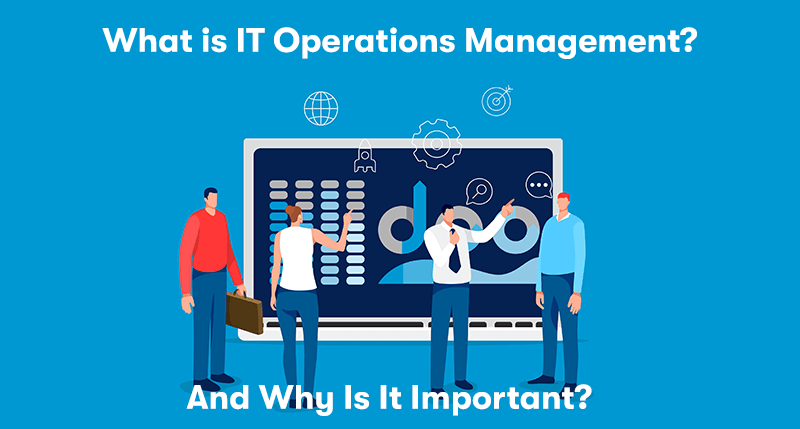What is ITOM (IT Operations Management) and Why Is It Important?
In the dynamic landscape of modern business, the role of IT Operations Management (ITOM) emerges as a cornerstone for organisational success. ITOM encompasses the comprehensive suite of practices and processes dedicated to ensuring the smooth, efficient operation of IT infrastructure and services. This pivotal management discipline not only guarantees the performance, availability, and security of IT environments but also aligns them with overarching business objectives.
The importance of ITOM cannot be overstated; it underpins the digital foundation upon which businesses innovate, compete, and thrive. As we delve into the nuances of ITOM, we uncover its critical functions, the inherent challenges it addresses, and its symbiotic relationship with IT Service Management (ITSM), shedding light on why ITOM is indispensable in today's technology-driven business ecosystem.
What is ITOM (IT Operations Management)?
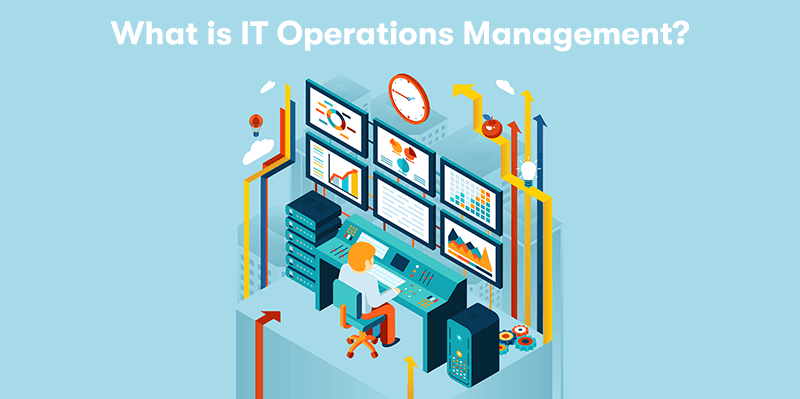
IT Operations Management refers to the overarching practice that ensures an organisation's IT infrastructure is managed, operated, and maintained efficiently. It encompasses a broad range of services and processes that support the IT infrastructure, including hardware, software, networks, and services, to ensure that they are available, performant, and secure. The goal of ITOM is to minimise downtime, improve service quality, manage costs, and ensure that IT operations align with the business objectives. Key components and practices within ITOM include:
Service Management
This involves managing IT services based on business needs. It includes practices such as IT Service Management, which focuses on aligning IT services with business needs.
Infrastructure Management
This involves managing essential operational components, such as hardware, servers, and networks, ensuring they are optimised for performance and availability.
Performance Monitoring
Monitoring tools and practices are used to continuously monitor IT infrastructure and services for issues that could impact performance or availability.
Security Management
Implementing and managing security policies and technologies to protect data, applications, and infrastructure from threats.
Change Management
Managing changes to the IT environment in a controlled manner to prevent disruptions.
Incident and Problem Management
Identifying, resolving, and analysing incidents and problems to minimise their impact on the business.
Asset Management
Keeping track of IT assets, including hardware, software, and licenses, to manage costs and compliance.
Capacity Planning
Ensuring the IT infrastructure scales effectively to meet future business requirements.
Disaster Recovery and Business Continuity
Planning and implementing strategies to recover from disasters and ensure business operations can continue.
ITOM tools and software solutions play a crucial role in automating and streamlining these tasks, offering dashboards, analytics, and management capabilities that help IT teams maintain oversight and control over their IT environments. This, in turn, supports business continuity, improves service delivery, reduces costs, and enhances overall organisational efficiency.
Why is ITOM Important?
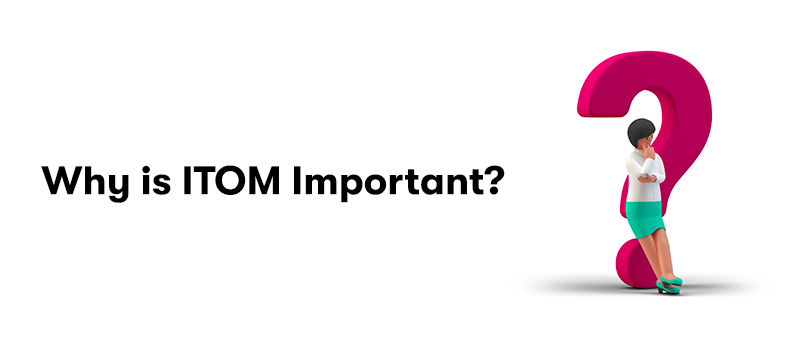
IT Operations Management is crucial for organisations for several reasons, reflecting its impact on efficiency, risk management, and strategic alignment. Here's why ITOM is important:
Ensures High Availability and Reliability
ITOM practices help ensure that IT services and infrastructure are always available and performing optimally. This is critical for businesses that rely on IT for their day-to-day operations, as downtime can lead to lost productivity, revenue, and customer trust.
Improves Service Quality
By managing IT operations effectively, organisations can improve the quality of their IT services. This includes faster resolution of issues, improved performance, and better user experiences, which can enhance customer satisfaction and loyalty.
Facilitates Cost Optimisation
ITOM allows organisations to make better use of their IT resources, optimising costs by reducing waste, improving efficiency, and ensuring that investments in IT infrastructure and services deliver the best value for the business.
Enhances Security Posture
With the increasing frequency and sophistication of cyber threats, managing IT operations includes prioritising security measures. ITOM practices help identify vulnerabilities, implement security controls, and respond to incidents, thereby protecting sensitive data and IT assets.
Supports Strategic Decision Making
Effective ITOM provides leaders with critical insights into IT performance, resource utilisation, and operational risks. This information is invaluable for strategic planning, helping to align IT operations with business objectives and market demands.
Enables Scalability and Flexibility
As businesses grow and evolve, their IT needs change. ITOM practices include capacity planning and performance management, ensuring that IT infrastructure can scale and adapt to meet these changing needs without unnecessary expenditure or disruptions.
Improves Compliance and Risk Management
Organisations are often subject to regulatory requirements regarding data protection, privacy, and IT governance. ITOM practices help ensure compliance with these regulations, reducing the risk of legal penalties, data breaches, and reputational damage.
Facilitates Better Change Management
IT environments are constantly changing, with new deployments, updates, and changes happening regularly. ITOM includes change management processes that ensure these changes are implemented smoothly and without negatively impacting service quality or availability.
Promotes Proactive Problem Solving
Instead of reacting to issues as they arise, ITOM encourages a proactive approach to managing IT operations. This involves monitoring, predictive analysis, and preventive maintenance to identify and address potential issues before they impact the business.
Enhances Collaboration and Communication
ITOM practices often involve coordination across different IT teams and with other business units. This fosters better communication and collaboration within the organisation, leading to more cohesive and aligned operations.
In summary, ITOM is essential for maintaining operational excellence, supporting business continuity, and enabling strategic growth. It helps organisations navigate the complexities of modern IT environments, ensuring they can meet current and future challenges effectively.
What are the Functions of IT Operations Management?

IT Operations Management encompasses a wide range of functions designed to ensure the effective and efficient operation of an organisation's IT infrastructure and services. These functions are critical for maintaining system availability, security, and performance and aligning IT services with business needs. Here are some of the core functions of ITOM:
Network Management
This involves overseeing the organisation's computer networks to ensure they are functional, secure, and efficient. Network management includes monitoring network performance, troubleshooting issues, and managing network resources.
Server Management
This function focuses on managing physical and virtual servers to ensure they operate efficiently and remain available. It involves server setup, configuration, monitoring, maintenance, and performance optimisation.
Storage Management
Storage management involves overseeing data storage solutions to ensure data is stored securely and can be accessed efficiently. This includes managing storage infrastructure, optimising storage resources, and implementing data backup and recovery solutions.
Application Management
This function entails managing and monitoring applications to ensure they meet performance and availability standards. It includes deploying, updating, and troubleshooting applications, as well as ensuring they are secure and compliant with relevant regulations.
Service Management
IT service management is a key component of ITOM, focusing on designing, delivering, managing, and improving the IT services an organisation provides to its end-users. ITSM frameworks, such as ITIL (Information Technology Infrastructure Library), offer structured guidance for managing IT services effectively.
Security Management
This involves implementing and managing security policies, tools, and procedures to protect data, applications, and infrastructure from threats. Security management is critical for preventing data breaches, ensuring compliance with data protection regulations, and protecting organisational assets.
Data Centre Management
Data centre management includes overseeing the physical and virtual infrastructure of data centres to ensure they are efficient, secure, and scalable. This involves managing power and cooling systems, server hardware, storage, and networking equipment.
Disaster Recovery and Business Continuity
This function involves planning and implementing strategies to recover IT systems and data in the event of a disaster and to ensure the continuity of business operations. It includes regular backups, disaster recovery planning, and business continuity exercises.
Change Management
Change management in ITOM involves overseeing changes to the IT environment to minimise the impact on services. This includes managing the deployment of new systems, updates, and patches in a controlled manner.
Incident and Problem Management
This function focuses on identifying, resolving, and analysing incidents and problems that affect IT services. The goal is to restore regular service operations as quickly as possible and prevent the recurrence of incidents.
Performance Monitoring
Monitoring the performance of IT systems and services is crucial for identifying and addressing issues proactively. This includes using monitoring tools to track system health, resource utilisation, and user experience.
Compliance and Risk Management
Ensuring that IT operations comply with relevant laws, regulations, and standards is a key function of ITOM. This involves regular audits, risk assessments, and the implementation of controls to manage risks.
These functions are interrelated and work together to ensure the smooth operation of an organisation's IT environment, supporting the overall business objectives. Effective ITOM leverages technology, processes, and policies to optimise IT operations, enhance service quality, and mitigate risks.
What is Difficult About ITOM?
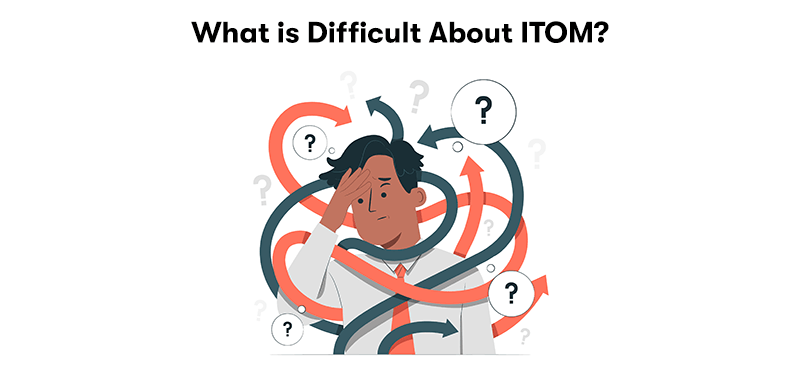
IT Operations Management is a critical yet challenging domain within organisations, primarily due to the complexity of modern IT environments and the rapid pace of technological change. Here are some of the key difficulties associated with ITOM:
Complexity of IT Environments
Modern IT environments are often highly complex, integrating a mix of legacy systems, cloud services, mobile platforms, and IoT devices. Managing these diverse and interconnected components to ensure seamless operation is a significant challenge.
Rapid Technological Advancements
The IT landscape is constantly evolving, with new technologies, platforms, and methodologies emerging regularly. Keeping up with these changes, integrating new technologies into existing IT operations, and ensuring staff are up-to-date with necessary skills can be daunting tasks.
Cybersecurity Threats
The increasing sophistication and frequency of cybersecurity threats pose a constant challenge for ITOM. Ensuring that the organisation's IT infrastructure is secure against such threats requires continuous vigilance, up-to-date security practices, and robust incident response strategies.
Ensuring High Availability and Performance
Organisations depend heavily on IT services for their daily operations. Ensuring these services are always available and performing optimally, especially in the face of growing demands and limited resources, is a complex and ongoing challenge.
Compliance and Regulatory Requirements
Adhering to industry regulations and compliance standards (such as GDPR, HIPAA, etc.) adds another layer of complexity to ITOM. Organisations must ensure their IT operations comply with relevant laws, which can vary across regions and industries, adding to the workload and requiring specialised knowledge.
Change Management
Managing changes within the IT environment, from software updates to major system overhauls, without causing service disruptions requires meticulous planning and coordination. The dynamic nature of IT operations makes change management a challenging but essential task.
Balancing Cost with Performance and Security
Budget constraints often limit what IT operations can achieve. Balancing the need for high-performance IT services and robust security measures with the available budget is a constant challenge for IT leaders.
Talent Acquisition and Retention
The demand for skilled IT professionals exceeds supply in many areas. Finding and retaining talent with the necessary skills for ITOM is challenging and can hinder the effectiveness of IT operations.
Data Volume and Analysis
Organisations generate vast amounts of data. Effectively managing, analysing, and leveraging this data to improve IT operations and make informed decisions is a significant challenge due to the volume, velocity, and variety of the data.
Integration and Interoperability
Ensuring different IT systems, both old and new, can effectively communicate and work together is essential for smooth operations. These integration and interoperability challenges can be complicated by proprietary systems and legacy technologies.
Aligning IT and Business Goals
Aligning IT operations with overall business strategies and objectives is crucial but can be challenging to achieve. Ensuring IT initiatives support business goals requires constant communication and collaboration between IT and business leaders.
Addressing these challenges requires a strategic approach to ITOM, leveraging automation, adopting best practices and frameworks (like ITIL), investing in training and development for IT staff, and maintaining a proactive stance towards IT management.
How Does ITOM Relate to ITSM?
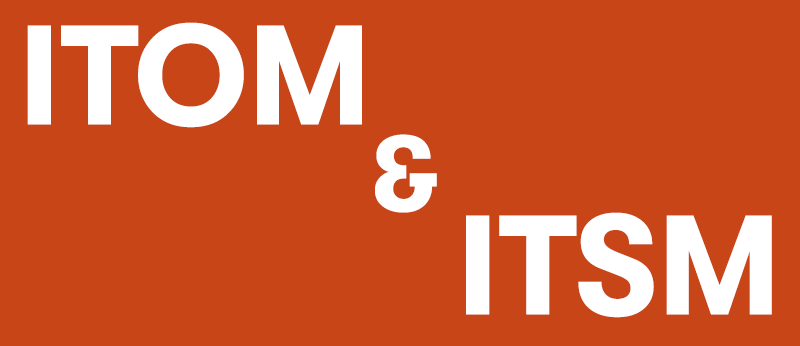
IT Operations Management and IT Service Management are both crucial domains within the broader field of IT management, focusing on ensuring that an organisation's IT services and infrastructure are aligned with its business objectives. While they are closely related and often overlap, each has its distinct focus and set of practices. Understanding the relationship between ITOM and ITSM is key to comprehending how they contribute to the overall efficiency and effectiveness of IT services.
ITOM Overview
ITOM deals with the operational aspects of managing IT infrastructure and services, focusing on the technical components and capabilities needed to deliver high-quality IT services. This includes managing servers, networks, storage, and security, as well as ensuring that all IT operations are running smoothly and efficiently. ITOM is concerned with the day-to-day tasks necessary to keep the IT infrastructure operational, secure, and optimised for performance.
ITSM Overview
ITSM, on the other hand, focuses on the management of IT services from the perspective of how they align with and support business needs. It encompasses the processes and activities involved in designing, creating, delivering, supporting, and managing the lifecycle of IT services. ITSM is guided by frameworks and best practices, such as ITIL (Information Technology Infrastructure Library), which provides structured approaches to managing IT services with an emphasis on customer service and quality management.
Relationship Between ITOM and ITSM
Foundational Support: ITOM provides the foundational support necessary for ITSM to function effectively. Without the operational stability and efficiency provided by ITOM, ITSM processes could not be effectively implemented or sustained.
Operational Excellence for Service Delivery: ITOM focuses on operational excellence, which is essential for the delivery of high-quality IT services outlined by ITSM. ITSM defines the services, and ITOM ensures these services are delivered efficiently, reliably, and securely.
Integrated Approach: Many organisations integrate ITOM and ITSM practices to ensure that a robust and efficient IT infrastructure supports the management of IT services (ITSM). This integrated approach helps align IT services more closely with business objectives, enhances service quality, and improves customer satisfaction.
Continuous Improvement: Both ITOM and ITSM are involved in continuous improvement processes. ITSM often drives the identification of areas for improvement in service management, while ITOM focuses on the continuous enhancement of operational processes and infrastructure performance.
Conclusion
In summary, while ITOM and ITSM have distinct focuses—operational management vs. service management—they are complementary and interdependent. ITOM ensures the IT infrastructure is optimised and functioning correctly, which is a prerequisite for effective IT service management as outlined by ITSM. Together, they ensure that IT services are not only aligned with the business's needs but are also delivered in an efficient, reliable, and secure manner.
Final Notes on IT Operations Management
In conclusion, the exploration of IT Operations Management and its significance reveals the intricate layers of managing IT infrastructure and services to align with business goals. We've dissected the core functions of ITOM, the challenges it presents, and its relationship with IT Service Management, highlighting their complementary roles in achieving operational excellence and service quality. This synergy ensures not only the smooth operation of IT services but also their alignment with business needs, enhancing efficiency, security, and customer satisfaction.
As organisations continue to navigate the complexities of digital transformation, understanding and implementing best practices in ITOM and ITSM remains critical for sustaining growth, competitiveness, and innovation in the ever-evolving IT landscape.


